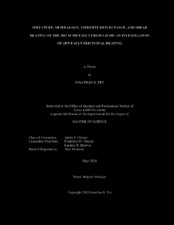| dc.contributor.advisor | Chester, Judith S | |
| dc.creator | Fry, Jonathan Robert | |
| dc.date.accessioned | 2020-12-17T19:27:24Z | |
| dc.date.available | 2022-05-01T07:14:22Z | |
| dc.date.created | 2020-05 | |
| dc.date.issued | 2020-04-15 | |
| dc.date.submitted | May 2020 | |
| dc.identifier.uri | https://hdl.handle.net/1969.1/191637 | |
| dc.description.abstract | This study focuses on the 3067 m MD fault captured in core recovered from the western damage zone of the San Andreas fault during Phase 1 drilling of the San Andreas Fault Observatory at Depth (SAFOD) before the borehole intersected the main trace of the San Andreas fault near Parkfield, California. The main goal of this study was to determine if there was evidence of slip-induced frictional heating using vitrinite reflectance gethermometry of organic material in the host rock and shear zone. The 3067 m MD fault juxtaposes a siltstone and an arkosic sandstone across the shear zone that displays inhomogeneous deformation. The host lithologies and shear zone were described according to their elemental and mineralogical composition. Numerical modeling of frictional heating from fault slip constrained possible orientations of the fault during slip, maximum temperature within the shear zone and host rock during and after slip, and expected vitrinite reflectance response of organic particles following slip magnitudes of 0.01 to 0.05 m. Four distinct structural units were identified within the shear zone and characterized by a reduction in grain size, development of shear textures, and an increase in clay and indistinguishable phases. The 3067 m MD fault displays localization of slip and comminution, consistent with, but not unique to seismic slip. The fault rock also contains evidence of physical and mineralogical alteration associated with faulting. Vitrinite reflectance values across the 3067 m MD fault average ~1.7% Ro compared to the modeled maximum predicted reflectance of 1.3% Ro due to burial, consistent with faults showing large cumulative slip. Numerical modeling of stress orientation suggests a sub-vertical fault orientation and coefficient of sliding friction of 0.4. At these conditions observed reflectance values are explained by a slip magnitude of 0.03 m on a 0. 5 mm thick shear zone producing a maximum temperature of ~1000 °C. The high-vitrinite-reflectance particles could reflect some localized seismic heating. | en |
| dc.format.mimetype | application/pdf | |
| dc.language.iso | en | |
| dc.subject | Earthquake processes | en |
| dc.subject | Fault zone mineralogy | en |
| dc.subject | Fault mechanics | en |
| dc.title | Structure, Mineralogy, Vitrinite Reflectance, and Shear Heating of the 3067 m MD Fault from Safod: An Investigation of Off-Fault Frictional Heating | en |
| dc.type | Thesis | en |
| thesis.degree.department | Geology and Geophysics | en |
| thesis.degree.discipline | Geology | en |
| thesis.degree.grantor | Texas A&M University | en |
| thesis.degree.name | Master of Science | en |
| thesis.degree.level | Masters | en |
| dc.contributor.committeeMember | Chester, Frederick M | |
| dc.contributor.committeeMember | Barroso, Luciana R | |
| dc.type.material | text | en |
| dc.date.updated | 2020-12-17T19:27:24Z | |
| local.embargo.terms | 2022-05-01 | |
| local.etdauthor.orcid | 0000-0002-0944-9045 | |


